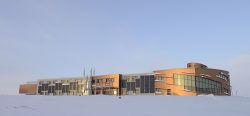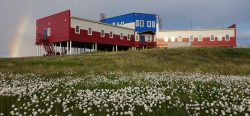Contact Details
PO Box 1450
191 Mackenzie Road
Inuvik, NT, X0E 0T0
CANADA
- Phone: +1 867-777-3298 x 232
- Link: http://nwtresearch.com
Shortlist from Station Catalogue over facilities and science disciplines.

NAME AND OWNER
The Western ArcticDefinitions of the Arctic vary according to environmental, geographical, political, cultural and scientific perspectives. Some scientists define the Arctic as areas having a high latitude, long winters, short, cool summers,... More Research Center (WARC) is operated by the Aurora Research Institute and Aurora College. The station is owned by the Government of the Northwest Territories (NWT).
LOCATION
WARC is located in the town of Inuvik, Northwest Territories, in the western Canadian ArcticDefinitions of the Arctic vary according to environmental, geographical, political, cultural and scientific perspectives. Some scientists define the Arctic as areas having a high latitude, long winters, short, cool summers,... More. WARC provides logistical support for research projects taking place throughout the northern NWT (including the archipelago) and along the northern Yukon coast. Inuvik straddles the boundary between two aboriginal land claim areas recognized by the Government of Canada; the Inuvialuit Settlement Region to the north and the Gwich’in Settlement Area to the south. The surrounding area is a mix of aboriginal private lands, crown (public) lands, and municipal areas. There are many protected areas in the vicinity of WARC, including bird sanctuaries, national parks and territorial parks.
BIODIVERSITY AND NATURAL ENVIRONMENT
Inuvik is located two degrees above the Arctic CircleA line of latitude currently at 66° 33? 44? (66.5622°) north of the Equator. It is the southern limit of the region of the Earth that experiences the 'midnight sun'.... More, but just south of the treeline, in a region underlain by continuous permafrostPermafrost is frozen ground that remains at or below zero degrees Celsius (32 degrees Fahrenheit) for two or more years. It forms in regions where the mean annual temperature is... More. The town sits approximately 100 km south of the Beaufort Sea coastline on the eastern edge of the Mackenzie River Delta (13,000 km2 in area). The delta contains over 45,000 lakes, and experiences some degree of flooding during the ice breakup period each spring. The surrounding landscape includes a wide variety of ecoregions, including tundraA type of ecosystem in which tree growth is limited by low temperatures. The origin of the word is from from the Kildin Sami word t?ndâr, meaning "uplands" or "treeless mountain tract". In the northern... More, mountains (the Richardson Mountains, on the west side of the Mackenzie Delta), coastal zones, and peatPeat is a soil type formed from slowly decomposing vegetation. It is found in wet areas where the lack of oxygen slows the breakdown of plant matter. Peatlands are areas... More plateaus. Characteristic regional faunaThe animals that live in a particular region, habitat or time (such as geological period like the jurassic). For plants, we use the term flora, and to collectively refer to all... More include bears, reindeer, caribou, water fowl and shore birds, beluga whales, moose, and a variety of fresh- and salt-water fish
HISTORY AND FACILITIES
A research center first opened in Inuvik in 1964; the original facility was torn down in 2010 and replaced with the Western ArcticDefinitions of the Arctic vary according to environmental, geographical, political, cultural and scientific perspectives. Some scientists define the Arctic as areas having a high latitude, long winters, short, cool summers,... More Research Center, which opened in 2011. WARC contains a conference room, classroom, three laboratories, a research library, a staging area/loading bay, a workshop, and office space for 15 people. Accommodations are a 10-minute walk from WARC in a residential neighbourhood, and include 4 houses each containing 6 beds, living space, a kitchen, a full bathroom, and laundry facilities. Some extra accommodations are available in the Aurora College dorms during the summer season. WARC can support between 24 and 34 people in our accommodations, and up to 75 in our main facility, at any given time.
GENERAL RESEARCH AND DATABASES
Research undertaken and supported at WARC is wide ranging, and includes archaeologyThe study of past human activity, mainly through studying artefacts and structures left behind, and by revealing other evidence of past activities. The first systematic archaeological excavations in the Arctic... More, permafrostPermafrost is frozen ground that remains at or below zero degrees Celsius (32 degrees Fahrenheit) for two or more years. It forms in regions where the mean annual temperature is... More, limnology, oceanography, geologyThe study of the solid Earth, rocks and processes by which rocks form. 'Geo' is derived from the Greek word for Earth.... More, spatial information sciences, botany, renewable energy (solar and wind), atmospheric sciences, wildlife, fisheries, and marine mammal health. Social sciences, health sciences, and traditional knowledge studies are also frequently supported. Each year, we support more than 50 separate research projects. The Aurora Research Institute (ARI) maintains the NWT Research Database, which is a searchable database of all research licenses issued by ARI since 1974; this resource can be used to explore past research in the western ArcticDefinitions of the Arctic vary according to environmental, geographical, political, cultural and scientific perspectives. Some scientists define the Arctic as areas having a high latitude, long winters, short, cool summers,... More region
HUMAN DIMENSION
WARC is located in the town of Inuvik (population 3,300), which is a regional center for government and industry. The region surrounding Inuvik is the homeland of the Inuvialuit and Gwich’in indigenousBelonging to a certain place. Indigenous people are distinct ethnic groups that have historic connections to people who lived in a territory prior to the area being colonized or coming... More peoples, while the town itself is home to both groups as well as people from many different cultures. The public sector (territorial and Canadian governments) is the largest employer, including health care workers, educators, and administrators. The town itself is very well equipped with amenities and services.
ACCESS
Inuvik is accessible via the Dempster Highway for most of the year, except for periods in the spring and fall when both the local ice roads and ferries aren’t in operation. Air service runs year-round, and includes daily jet service from Edmonton, Yellowknife, and Whitehorse. The Inuvik Regional Airport is a 15 minute drive from the town, with readily-available cab service. Depending on destination and season, field transportation can include car/truck, snowmobile, boat, charter plane, or helicopter.





















